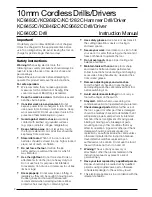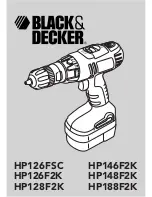
■
16
│
GB
│
IE
PDMH 4500 B5
■
Avoid direct contact with the machine tool
during and after use as it may be hot .
■
Suitable safety goggles must be worn; wearing
protective gloves and safety clothing is recom-
mended .
Hazards caused by repetitive
movements
■
Users of non-rotary, percussive tools may experi-
ence unpleasant sensations in their hands, arms,
shoulders, neck area or other body parts while
working with the tools .
■
Assume a comfortable position when working
with this non-rotary percussive tool, ensure that
you have a firm footing and avoid unfavourable
positions or positions in which it is difficult to
keep your balance . During work over extended
periods, the operator should change posture to
avoid discomfort and fatigue .
■
If the operator notices symptoms such as persis-
tent discomfort, throbbing, pain, tingling, burn-
ing or stiffness, these warning indications should
not be ignored .
Hazards caused by accessories
■
Disconnect the non-rotary percussive tool from
the power supply before attaching or replacing
the machine tool or accessory .
■
Use only accessories and consumables of the
sizes and types recommended by the manufac-
turer of the non-rotary percussive tool . Do not
use any other types or sizes of accessories or
consumables .
■
For hammers (if applicable): never use the chis-
els as hand tools . They are specially designed
for use in non-rotary percussive tools and
heat-treated accordingly .
■
For hammers and crushers (if applicable): never
use blunt chisels because they require excessive
pressure and may cause fatigue fractures . Blunt
tools can increase vibrations . Always use sharp
tools .
■
Never cool hot accessories in water when using
hammers (if applicable) . This can lead to brittle-
ness and premature failure .
■
In the case of hammers (if applicable), misuse
of the tool as a lever may result in chipping,
chisel breakage or damage to the tool . Work in
smaller sections to avoid snagging .
■
Avoid direct contact with the machine tool dur-
ing and after use because it may be hot or have
sharp edges .
Hazards in the workplace
■
Slipping, tripping and falling are the main caus-
es of injuries in the workplace . Look out for sur-
faces which could have become slippery
through use of the machine, and also any trip-
ping hazards caused by air or hydraulic hoses .
■
Proceed with caution in unknown surroundings .
There may be concealed hazards in the form of
power cables or other supply lines .
■
The non-rotary percussive tool is not intended
for use in explosive atmospheres nor insulated
against contact with electrical power sources .
■
Ensure that there are no electric cables, gas
pipes, etc . that could cause a hazard if dam-
aged by using the machine .
Hazards caused by dust and vapours
■
The dust and vapours that are produced by
using a non-rotary percussive tool can be haz-
ardous to health (e .g . cause cancer, birth de-
fects, asthma and/or dermatitis) . It is essential
to carry out a risk assessment with regard to
these risks and implement appropriate regulato-
ry mechanisms .
■
The risk assessment should include all dust caused
by the use of the machine and the existing dust
that may be kicked up at the same time .
■
The non-rotary percussive tool must be operated
and maintained in accordance with the recom-
mendations contained in this manual in order to
minimise the release of dust and vapours .
















































